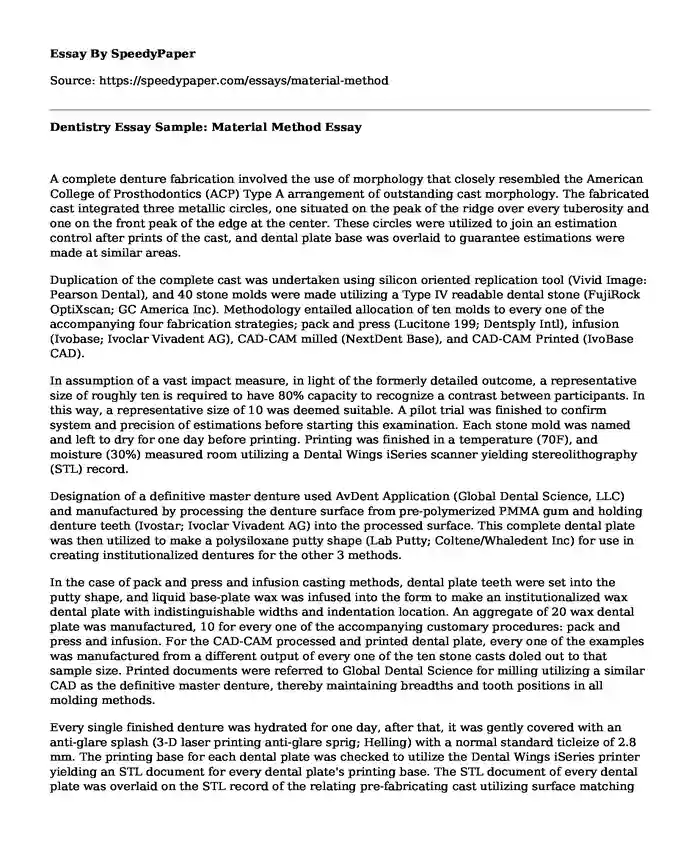A complete denture fabrication involved the use of morphology that closely resembled the American College of Prosthodontics (ACP) Type A arrangement of outstanding cast morphology. The fabricated cast integrated three metallic circles, one situated on the peak of the ridge over every tuberosity and one on the front peak of the edge at the center. These circles were utilized to join an estimation control after prints of the cast, and dental plate base was overlaid to guarantee estimations were made at similar areas.
Duplication of the complete cast was undertaken using silicon oriented replication tool (Vivid Image: Pearson Dental), and 40 stone molds were made utilizing a Type IV readable dental stone (FujiRock OptiXscan; GC America Inc). Methodology entailed allocation of ten molds to every one of the accompanying four fabrication strategies; pack and press (Lucitone 199; Dentsply Intl), infusion (Ivobase; Ivoclar Vivadent AG), CAD-CAM milled (NextDent Base), and CAD-CAM Printed (IvoBase CAD).
In assumption of a vast impact measure, in light of the formerly detailed outcome, a representative size of roughly ten is required to have 80% capacity to recognize a contrast between participants. In this way, a representative size of 10 was deemed suitable. A pilot trial was finished to confirm system and precision of estimations before starting this examination. Each stone mold was named and left to dry for one day before printing. Printing was finished in a temperature (70F), and moisture (30%) measured room utilizing a Dental Wings iSeries scanner yielding stereolithography (STL) record.
Designation of a definitive master denture used AvDent Application (Global Dental Science, LLC) and manufactured by processing the denture surface from pre-polymerized PMMA gum and holding denture teeth (Ivostar; Ivoclar Vivadent AG) into the processed surface. This complete dental plate was then utilized to make a polysiloxane putty shape (Lab Putty; Coltene/Whaledent Inc) for use in creating institutionalized dentures for the other 3 methods.
In the case of pack and press and infusion casting methods, dental plate teeth were set into the putty shape, and liquid base-plate wax was infused into the form to make an institutionalized wax dental plate with indistinguishable widths and indentation location. An aggregate of 20 wax dental plate was manufactured, 10 for every one of the accompanying customary procedures: pack and press and infusion. For the CAD-CAM processed and printed dental plate, every one of the examples was manufactured from a different output of every one of the ten stone casts doled out to that sample size. Printed documents were referred to Global Dental Science for milling utilizing a similar CAD as the definitive master denture, thereby maintaining breadths and tooth positions in all molding methods.
Every single finished denture was hydrated for one day, after that, it was gently covered with an anti-glare splash (3-D laser printing anti-glare sprig; Helling) with a normal standard ticleize of 2.8 mm. The printing base for each dental plate was checked to utilize the Dental Wings iSeries printer yielding an STL document for every dental plate's printing base. The STL document of every dental plate was overlaid on the STL record of the relating pre-fabricating cast utilizing surface matching application (Geo-enchantment Regulator 2014; 3D Frameworks). Utilizing this application, estimations were established at 60 for every one of the 40 dental plates utilizing an overlap manual for approving the area of the 60 estimations. Moreover, color surface charts were made to outwardly show the adjustment of the denture base embedded in the mold. The base coordinating and estimations gave the premise to the assessment of fit inconsistencies in the accompanying zones: the peak of the dental plate outskirt, 6 mm from dental plate fringe, the peak of the edge, sense of taste, and back palatal seal.
To decide if the variations between each fabricating method were empirically noteworthy, the Kruskall-Wallis investigation of difference was directed. This investigation examined the similarities of the fabricating method estimations by position and ascertained whether the variation was crucial. The standard mistake of revised approximations was 0.002 mm.
An assessment of average positions of misrepresentation among the fabricating strategies layered by the five areas of intrigue was directed utilizing the Kruskal-Wallis technique. Post hoc analyses were balanced for various analyses. Measurable inspection utilizing the Levene test was utilized to decide if the similarity and difference occurred in the fabricating methods. All trial of theories were 2-faced (a=.05).
Cite this page
Dentistry Essay Sample: Material Method. (2022, Oct 21). Retrieved from https://speedypaper.com/essays/material-method
Request Removal
If you are the original author of this essay and no longer wish to have it published on the SpeedyPaper website, please click below to request its removal:
- Literary Analysis on Death of a Salesman, Free Essay Example
- Free Essay Analyzing Rhetoric Devices Used by Martin Luther King and Malcolm X
- Essay Sample on Some Legal Aspects of Contracts
- Borderland problems and ways forward
- Free Essay - the Great Depression and the Great Recession of 2006-2007
- Free Essay. Comparing Pandora's Box and Eight and Half Men
- Paper Example on Opium, Rebellion, and Women Question in China
Popular categories





